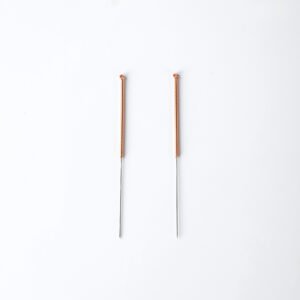针灸针
针灸针是针灸实践的核心,在传统中医中具有历史和治疗意义。针灸针起源于古代中国,已有 2000 多年的使用历史。这些针最初由石头、竹子和骨头制成,由于冶金学和医学科学的进步,针灸针有了很大的发展。尽管有这些发展,但其使用的基本原理仍然植根于古代气(生命能量)和经络(能量通路)的哲学。
在传统中医中,针灸针用于刺激身体上的特定穴位,以恢复气的流动平衡。这种做法深深植根于这样的信念:气的畅通流动对于保持健康和幸福至关重要。几个世纪以来,针灸针的技术和材料经历了重大变革。现代针灸针通常由不锈钢制成,可确保消毒和精确,同时最大限度地减少不适和不良反应的风险。
除了历史和文化意义之外,针灸针在当代治疗实践中也占有重要地位。如今,这些针不仅因其传统治疗特性而被广泛使用,还用于治疗各种现代健康问题。从慢性疼痛管理到减压和缓解各种疾病,如头痛、关节炎,甚至不孕症,针灸的范围已经大大拓宽。
针灸的基本原理是将这些细小、无菌的针小心地插入身体上的特定穴位。预期结果包括缓解身体症状、改善身体机能以及全面提高患者的生活质量。因此,针灸针仍然是传统和现代医学中不可或缺的工具,展现了古老智慧与现代创新的完美融合。
针灸针的种类
了解针灸针的类型对于医生和患者来说都至关重要,以确保治疗有效。针灸针有各种材质、尺寸和长度,每种针都有针对特定需求的独特优势。
首先,针灸针所用的材料对治疗有很大影响。不锈钢针是最常见的,因为它们耐用、经济高效、耐腐蚀。相反,金针和银针虽然不太常见,但也因其独特的性能而被使用。金针被认为可以刺激能量流动,常用于需要镇静效果的治疗,而银针被认为具有冷却效果,是减少炎症的理想选择。
针灸针的尺寸和长度各不相同,以适应不同的治疗部位和情况。针的直径通常在 0.12 毫米到 0.35 毫米之间。较细的针,例如 0.25 毫米以下的针,通常用于面部针灸或敏感部位,以尽量减少不适。较粗的针更适合组织较多的身体部位,如背部或腿部。长度也各不相同,通常从 15 毫米到 75 毫米不等,较长的针用于某些肌肉骨骼治疗所需的更深的组织穿透,较短的针用于浅表或脆弱的部位。
医生会根据多种因素选择合适的针头类型,包括患者的舒适度、预期刺激强度以及针对的特定穴位。例如,患有深层肌肉疼痛的患者可能需要更长更粗的针头,而寻求面部年轻化治疗的患者则需要更短更细的针头。
说明这些常见的针头类型可以让你更清楚:经典不锈钢针头用于一般用途,金针用于镇静和增强能量,银针用于冷却和消炎,每种针头的选择都基于预期的治疗方案。了解这些区别有助于制定有效且量身定制的针灸治疗。
针灸针的工作原理
针灸针在传统中医中发挥着重要作用,它通过控制人体内在的能量流(即气)来发挥作用。这种疗法的核心是经络,即能量通道,人们认为经络可以将气输送到全身。通过将细小的无菌针插入这些经络上的特定穴位,医生旨在调节气的流动,从而恢复平衡并促进健康。
气的原理是理解针灸针工作原理的基础。根据传统观念,气流中断或阻塞会导致身体和情绪疾病。针灸旨在缓解这些阻塞,使能量流动更加顺畅、不间断。这是通过精确的针刺位置和技术来实现的,这对于获得所需的治疗效果至关重要。
针灸可以影响多种生理过程,其中最重要的就是缓解疼痛。研究表明,针灸针的插入会刺激神经系统,导致内源性化学物质(如内啡肽)的释放。这些天然止痛药可以减轻疼痛感并促进放松。此外,针灸还可以通过引起血管舒张来增强血液循环,从而改善目标区域的血流量,从而促进组织愈合。
科学研究为针灸的机制提供了深刻见解。例如,功能性磁共振成像 (fMRI) 扫描显示针灸可以调节大脑活动,从而影响疼痛感知和情绪调节。此外,研究表明针灸可以刺激神经递质和激素(如血清素和皮质醇)的释放,这有助于控制压力和炎症。
针刺位置和技巧的重要性怎么强调都不为过。针刺师经过严格训练,掌握准确定位穴位和采用适当针刺技巧的技巧。针刺的深度和角度、留针时间,甚至针刺刺激方法(如手动捻转或电刺激)都会对治疗结果产生重大影响。
针灸的安全性和最佳实践
确保针灸治疗的安全性和有效性至关重要。其中最关键的方面之一是采用无菌技术。针灸针必须是一次性使用的,并且采用无菌包装,以消除交叉污染和感染的风险。从业者必须保持清洁卫生的环境,严格遵守医疗无菌规程,包括在针灸过程中彻底洗手和戴手套。
对针灸从业人员进行适当的培训和认证对于保证从业人员的专业水平和患者安全至关重要。信誉良好的培训计划提供全面的人体解剖学、病理状况和针刺技术教育。遵守美国国家针灸和东方医学认证委员会 (NCCAOM) 等监管机构制定的指导方针可确保从业人员达到高标准的执业水平。
针灸的主要风险包括针刺部位轻微出血、淤青和局部疼痛。然而,这些副作用通常很少见,可以通过熟练的针刺技术和彻底的患者评估来减轻。从业者应进行详细的病史回顾,以确定任何禁忌症,如出血性疾病或皮肤感染。适当的针插入深度和角度,以及正确的针保留时间,对于最大限度地减少不良反应至关重要。
患者准备和治疗后护理对获得良好的针灸体验有很大帮助。治疗前,应建议患者穿宽松的衣服,避免摄入过多的食物或咖啡因。治疗后,执业医师应提供治疗后休息和补水方面的指导,并指导患者监测可能需要跟进的任何异常症状。
找到一位获得认证且经验丰富的针灸师对于确保治疗安全有效至关重要。患者可以咨询 NCCAOM 等专业机构或各自国家的同等组织,以找到合格的从业者。这些监管标准和专业机构在维护针灸实践的质量和可信度方面发挥着关键作用。
针灸与针具简介
针灸是传统中医的重要组成部分,已有数千年历史。针灸起源于古代中国,其原理是平衡人体能量流,即“气”或“气”。这种历史悠久的疗法的从业者将细针插入身体的特定穴位,据说可以影响能量通道或经络,从而促进康复和健康。
历史上,针灸针是用石头、竹子或骨头等材料制成的。随着针灸实践的发展,这些针灸针逐渐被金属针取代,金属针的精度更高、效率更高。如今,针灸已被全球公认为一种辅助治疗技术,通常与传统医学疗法一起使用,以控制疼痛、压力和各种其他健康状况。
针灸所用的针头类型也经历了重大进步。现代针灸针通常由不锈钢制成,确保它们既耐用又灵活。一次性针灸针的出现标志着这种做法演变的关键时刻。与需要严格消毒程序的可重复使用针头不同,一次性针头设计为一次性使用,从而降低了交叉污染的风险并提高了患者的安全性。
人们越来越喜欢一次性针灸针,主要是出于对卫生和便利性的考虑。在临床环境中,确保绝对无菌是至关重要的;一次性针头可以消除可重复使用针头消毒不当带来的潜在危害。此外,一次性针头简化了手术流程,因为它们不需要耗时的消毒过程,让医生可以更专注于患者护理。
总之,从传统材料到现代不锈钢一次性用品的演变反映了针灸在保持其基本原则的同时接受当代医学标准的适应性。这一转变凸显了该领域内提高清洁度和操作效率的更广泛趋势,强调了一次性针灸针在当代针灸实践中的重要性。
使用一次性针灸针的优点
一次性针灸针的出现极大地改变了临床实践,确保了医生和患者的更高安全性和便利性。一次性针灸针最显著的好处之一是提高了安全标准。这些针头经过预先消毒并单独包装,消除了与可重复使用针头相关的各种风险,大大降低了交叉污染和感染的可能性。
与可重复使用的针头(每次使用后都需要进行严格的灭菌程序)不同,一次性针灸针设计为一次性使用。这消除了可能造成资源紧张的复杂且耗时的灭菌过程。对于从业者来说,这意味着可以将更多时间用于患者护理,减少维护时间,最终实现更高效的临床工作流程。
对于患者来说,使用新的、 无菌针头 每次治疗都增强了他们的信心和舒适度,这对于实现最佳治疗效果至关重要。知道可重复使用针头的不当消毒技术所带来的风险可以通过一次性选择完全避免,这让人感到非常安心。
从运营角度来看,在实践中使用一次性针灸针可简化库存管理。诊所可以最大限度地减少对高压灭菌机和其他消毒设备的投资,从而降低总体运营成本。这种转变还可以在临床环境中更好地控制卫生。
相比之下,可重复使用针头有几个缺点,这也凸显了一次性针头的优越性。需要对可重复使用针头进行持续彻底的消毒,这不仅耗费时间和资源,而且还存在消毒失败的固有风险。此外,重复使用造成的磨损会随着时间的推移降低可重复使用针头的功效,从而可能影响患者护理。
材料和制造工艺
一次性针灸针是精密设计的器械,主要由高级不锈钢制成。这种材料的选择至关重要,因为它具有抗腐蚀、强度和生物相容性,可确保消毒针头的安全使用。制造过程始于精心挑选不锈钢,然后将其精心塑造成细长的棒。
针杆的制作过程涉及多个阶段的拉拔和矫直,以确保厚度均匀、光滑无瑕。每根针杆都必须符合严格的尺寸规格,以满足针灸治疗的高标准。随后,将针杆切成适当的长度,并将末端削尖以形成针尖。削尖过程非常精确,以确保治疗期间无痛且有效插入。
切割和打磨后,针头会通过超声波清洗器和其他先进技术进行彻底清洗,以去除制造过程中产生的任何杂质或残留物。这一步骤对于保持针头的无菌性和安全性至关重要。然后实施质量控制措施,包括严格的检查和测试,以确保每根针头都符合严格的国际安全和功效标准。
生产过程中的一个关键方面是给针头涂上各种涂层。常见的涂层包括硅树脂,它可以减少摩擦,使插入更顺畅,并最大限度地减少患者的不适。这些涂层不仅可以提高性能,还可以确保针头在插入时不会损害皮肤的完整性。
在最后阶段,使用伽马射线或环氧乙烷气体等方法对针头进行消毒,确保针头不含任何可能导致感染的微生物。然后,每根针头都单独包装,以在使用前保持无菌状态。从原材料选择到包装的整个过程旨在提供高质量、可靠和安全的一次性针灸针,这对于提供有效的针灸治疗至关重要。
在选择一次性针灸针时,从业者必须考虑几个关键因素,包括针规、长度和品牌声誉。针规指的是针的直径,这是一个关键方面,因为它会影响治疗的舒适度和有效性。较小的针规(如 34 或 36)通常侵入性较小,更适合敏感区域,而较大的针规(30 或 32)通常用于更深的针刺技术。针的长度也因目标点和最佳治疗效果所需的深度而异。
品牌声誉是另一个重要标准。选择知名且信誉良好的品牌可确保针头符合高质量制造标准且无菌,这对患者安全至关重要。值得信赖的品牌通常经过严格测试并遵守行业基准,以提供可靠且安全的针灸针。
使用一次性针灸针的最佳做法涉及几个步骤
以确保医生和患者的安全。在进行针灸之前,针灸师应彻底洗手并戴上无菌手套。应使用适当的消毒液清洁患者皮肤上的治疗区域,以尽量减少感染风险。应精确插入针头,遵循适当的技术,例如快速轻柔地插入,以减少不适并增强治疗效果。
治疗结束后,必须按照监管指南处理使用过的针头。执业者应使用防刺穿锐器容器安全地丢弃针头。正确处理不仅可以确保安全,还可以通过防止针头污染和确保正确管理废物来履行环境责任。遵守这些监管标准对于在针灸实践中保持高水平的卫生和患者护理至关重要。
理解和实施这些考虑将大大提高针灸治疗的有效性和安全性,确保医生和患者都有积极的体验。







































![0.25*25mm(一英寸)无菌针灸针[100支/盒]](https://herbalr.com/wp-content/uploads/2024/08/Hf4bfaadeb6ba4c78b3d86da751000a474-300x300.avif)
评价
目前还没有评价